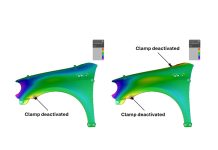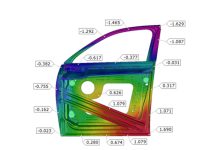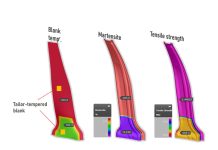Can a Conference Paper Be Published Without the Conference?
See how AutoForm’s Giampaolo Moncelsi and Leonard Krauss contributed to the cancelled NEHY 2020, Germany’s leading hydroforming conference.
The NEHY conference in Fellbach, southern Germany, is a renowned event for anyone interested in tube hydroforming and its research. AutoForm has contributed to NEHY in the past and AutoForm’s Giampaolo Moncelsi and Leonard Krauss prepared this paper on systematic process improvement for hydroforming. The NEHY 2020 event was justifiably cancelled. Therefore, we take this opportunity to represent the latest methods to avoid the struggle of manual optimization while adapting process parameters to axial tool displacement or hydroforming pressure. The paper demonstrates that simplified stochastic methodologies enable method planners to find suitable process windows for their critical parts in the shortest time possible.
In 2019, AutoForm’s Giampaolo Moncelsi (Technical Product Manager) and Leonard Krauss (Product Manager) confirmed to Prof. Liewald’s chair at the University of Stuttgart that they would produce a paper for NEHY 2020 (originally planned for 12 May 2020). At the time, we had no indication of the impending Covid-19 pandemic, along with the necessary travel restrictions and public health concerns. The conference program was published, registrations were made and speakers were announced on the web page. Everything was running according to plan…

Figure 1: Original conference program showing AutoForm’s keynote speech
As Covid-19 began to spread globally, the conference organizational committee agreed that cancelling the event was a necessary conclusion. Fortunately, the committee has nevertheless published all submitted papers in a conference transcript. If you are interested in learning the valuable information that AutoForm would have presented, the content is presented below:
The following is a common struggle when working on a proper process layout: The process itself has already reached a reasonable level of quality, but the part still shows some areas with (e.g.) high thinning values that are out of tolerance. In addition, the tube still indicates some material saving potentials, which cannot be ignored because reducing part costs is crucial. So how can these issues be solved?
Typically, these obstacles are overcome by manually detecting the correct process parameters and running simulation after simulation. This is what we call an iterative process. In contrast, the paper’s title, “CAE-based optimization of tube hydroforming processes – balancing quality and cost criteria” reflects AutoForm’s goal of providing simple and flexible functionalities that enable the optimization of both quality and cost criteria at the same time. To accomplish this, a systematic approach is used, which allows the simultaneous prediction of each chosen process parameter’s influence on the final part result (Fig. 2).

Figure 2: Process comparison of a systematic and an iterative approach
As shown in Fig. 2, the systematic approach undergoes a new loop, which is in high contrast to the iterative approach. This means that only one simulation needs to be started after the process variables are defined. It may seem difficult to conceptualize, but it is incredibly simple to realize.
For the purposes of the paper, an engine cradle is investigated (Fig. 3). The part’s dimensions are 766x722x65mm, with a tube thickness of 3.5mm and an initial tube diameter of 55mm. For the material definition, an aluminum alloy EN AW-6014 T61 was used. The initial simulation before systematic optimization showed different quality issues regarding splits and contact distance. In addition, the material optimization had not been taken into account to reduce cost.

Figure 3: Geometry of the investigated engine cradle
Before starting the simulation, certain parameters that will influence the process need to be defined. This is done by not only activating the parameter for variation but also by defining a variation range. No further input is necessary. The final process setup for the investigated engine cradle is shown in Fig. 4.

Figure 4: Varied parameters for simulation
Common quality influencing parameters including initial tube diameter, axial displacement and final pressure are defined for variation. Additionally, cost-driven parameters like the addendum length are considered simultaneously. This allows for a balanced evaluation of contradictory targets, namely quality and cost. But how does the simulation predict the correct results?
The systematic approach uses statistical methodologies to determine a good match between simulation prediction and real result. Fortunately, the user doesn’t need to scrutinize the background statistical process occurring in the software. The sample generation is performed automatically, so that the simulation can be evaluated immediately following completion. Of course, the definition of allowed tolerances is necessary in order to fulfill quality needs. The applied tolerances are shown in Table 1. Thinning considers the reduction of tube thickness due to plastic deformation while the contact distance reflects the distance between tube and tool, to achieve tube calibration.

Table 1: Tolerance limits for evaluation
Regarding evaluation, AutoForm’s TubeXpert provides a helpful tool kit. The software is capable of automatically detecting part issues based on the defined tolerance limits. The detected issues also allow for an automatic solution suggested by the software, with just one mouse click. However, since only quality criteria are defined within the tolerances, some additional work is necessary.
This is also a very quick step, as the tool kit offers parameter sliders and 2D process windows to provide assistance during evaluation. The sliders can be moved between the defined limits, e.g., between 40mm and 80mm for the addendum’s feed length. The simulation result is then shown instantaneously based on the underlying predicted simulation result. The 2D process window even goes one step further by showing meaningful areas where tolerances are met (Fig. 5).

Figure 5: 2D process window evaluation
The final solution provides an excellent outcome for both defined quality criteria and cost minimization. The systematic optimization leads to a volume-based material saving of 7.34%, based on an initial tube length reduction from 2130.5mm to 2110.5mm due to a shorter addendum feed. This corresponds to a part weight reduction of 0.24kg. The initial tube material volume has been reduced from 1206.43cm³ to 1117.87cm³. At the same time, all quality related issues lie within the defined limits. Regarding quality issues, the maximum thinning value is 24.6%, while the maximum outer contact distance shows a value of 0.356mm.
To guarantee agreement between the predicted and actual results, a control simulation is required, using the determined parameter set as a basis. The results show a valid match between the two simulations. Maximum thinning lies within the same area, with a value of 23.2% (predicted: 24.6%) and a maximum outer contact distance of 0.326mm (predicted: 0.356mm). This shows a strong comparability between statistic prediction and control simulation.
The systematic process optimization in AutoForm’s TubeXpert is a huge advantage when identifying valid parameter combinations for quality and cost optimization. Time and money can be saved by circumventing manual optimizations and making use of modern software capabilities. Stay healthy and see you at upcoming events,
Giampaolo Moncelsi and Leonard Krauss
New readers, don’t forget to sign up to our blog to stay updated. We’ll never send you any marketing emails. Just a small reminder now and then about our top posts.













